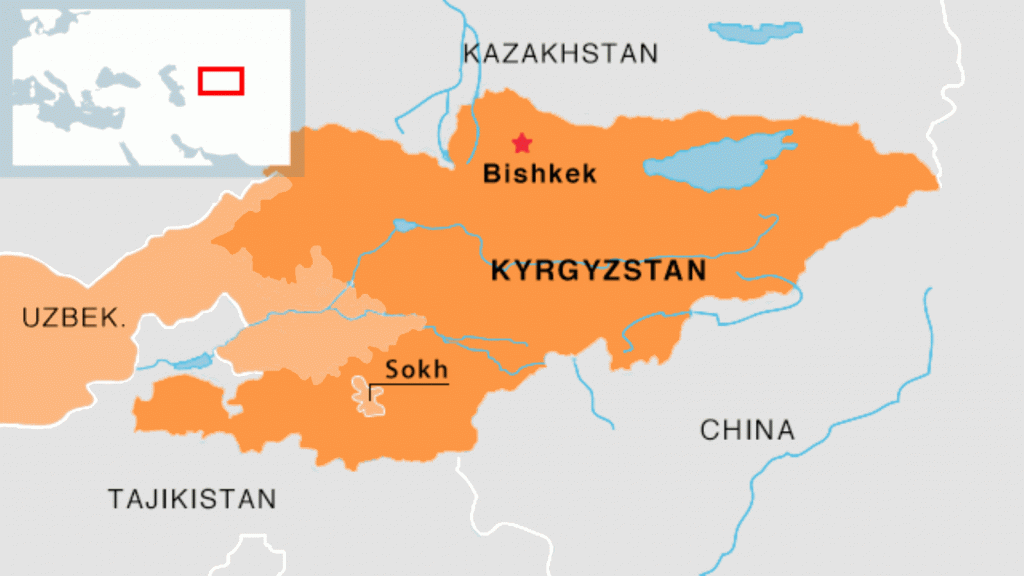Clashes in Ferghana: Causes and Responses
Recent Articles
Author: Leah Silinsky
06/21/2020
On May 31, clashes erupted in the Sokh region of the Ferghana valley between Kyrgyz residents from Chechme and Uzbek villagers from Chashma over the ownership of a local spring. Over 25 people were seriously injured, four of whom were hospitalized. While the Uzbek Border Guard Service states that the conflict had been resolved, there is no certainty that future conflicts will not occur. This is especially true considering the history of ethnic tension in the Sokh region of the Ferghana Valley. On June 5, Uzbekistan’s official presidential website stated that Uzbekistan’s President Shavkat Mirzioyev left to tour the Ferghana valley. However, it did not specify whether Mirzioyev planned to tour the Sokh region.
Abdulla Aripov, Uzbekistan’s Prime Minister, had stated on June 1 that President Mirzioyev would visit the Ferghana Valley. This was a day after clashes occurred. That same day, Aripov and Kyrgyz Deputy Prime Minister Kubatbek Boronov met at the Chechme-Avtodorozhniy checkpoint to discuss the recent events. Boronov and Aripov agreed to a joint investigation to bring those involved in the clashes to justice and made a point of increasing bilateral cooperation. Mirzioyev’s press team later commented on the joint meeting, stating support for joint bilateral cooperation. Many argue that Mirzioyev’s leadership differs from that of former president Islam Karimov, noting that Mirzioyev, unlike Karimov, desires increased cooperation between Uzbekistan and Kyrgyzstan. Ethnic conflict is not new to the Sokh enclave, or the Ferghana Valley in general. In 2013, there were many clashes between residents and Kyrgyz border guards over the installation of electric power lines. These clashes resulted in 30 Kyrgyz residents being taken hostage, and five were shot by border guards. After the clashes, many border crossings were closed.

Map of the Sokh enclave in the Ferghana Valley. Source: RFE/RL
While an Uzbek enclave, Sokh is predominantly composed of ethnic Tajiks. The Sokh enclave is only one of the various border areas with endemic ethnic conflict. After the Soviet Union fell in 1991, the Central Asian border areas saw a sharp rise in ethnic conflict, especially in the Ferghana Valley, where the borders of Kyrgyzstan, Tajikistan, and Uzbekistan all intersect. The Osh riots of 1990 and 2010 are only a few examples of such strife in the region. The Ferghana Valley has also experienced a growth in Islamist movements since the fall of the Soviet Union.
In light of the recent clashes, the government of Uzbekistan has promised to increase investment in the Sokh valley. While this could be helpful, many are wary of the effects of this investment. This is especially true after a police chief was named as head of the district, despite being distrusted by many residents. Some residents present at the May 31 clashes do not trust the authorities, alleging that they are hiding information from the public about the riots.
Overall, while an increase in bilateral cooperation and investments might be helpful, it is unlikely that the Ferghana Valley will see a sharp reduction in conflict. Such conflict is not exclusive to the Sokh enclave but, rather, is a feature of the region itself. It is likely that Islamist groups like Hizb-Tahrir (HT) will take advantage of the ethnic divisions and social discord to recruit members into their movements. It is also likely that Russia and China will take advantage of the division to spread disinformation, to sow discord increase Central Asian dependence on these large powers. Russia is an expert at online disinformation campaigns in its conflicts with Georgia and Ukraine. Considering the amount of influence Russia has in Central Asia, there is no reason to doubt that the Kremlin will take advantage of ethnic problems in the Ferghana Valley.